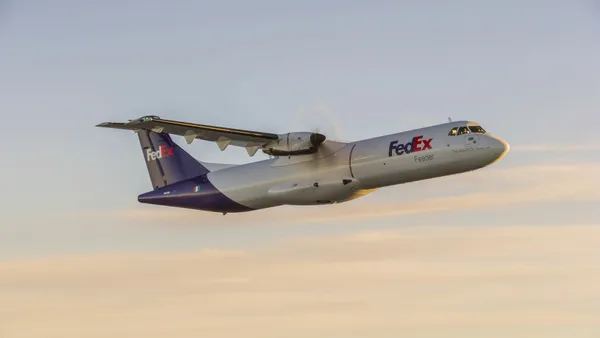Dive Brief:
- Global air cargo spot rates in August sank to their lowest level in more than three years at $2.19 per kilogram, Xeneta’s Clive Data Services reported this month.
- Out of 10 major trade lanes, only China-U.S. and Southeast Asia-U.S. saw growth in the past month, with spot rates up 3% and 4%, respectively, Clive reported. This was attributed to a more resilient U.S. economy and, in part, the delayed recovery of U.S.-China bellyspace capacity.
- “There is likely to be upward pressure on airfreight rates in the second half of October as capacity is taken out of the market,” said Xeneta Chief Airfreight Officer Niall van de Wouw. “But it’s getting late in the game to positively impact the industry’s 2023 performance, and the signals for the rest of the year are not good given the macroeconomic outlook hasn’t improved.”
Dive Insight:
Falling air freight rates paired with growing capacity and yet another month of softening global demand has dampened hopes for a rise in volumes in the back half of the year. Van de Wouw noted that it might be another few quarters before the industry sees demand rebound.
“August was very quiet, like July, and we see no meaningful signals from a qualitative or quantitative point of view of any kind of peak arising this year,” van de Wouw said. “There might be some early peak season charter requests floating around, but they are backed up by very little demand. The (low) rates and the limited timeframe that the requestors are looking for signal that they are not too concerned at the moment about getting the required capacity when they actually need it.”
The ocean freight container market may still share some indication of where the air freight market is heading, van de Wouw said. Maritime shipping’s annual peak season, which typically precedes the air freight cycle by a couple months, also failed to show any peak trends. “There are even blank sailings scheduled ahead of the Golden Week period,” he said.
Even restrictions on containers moving through the Panama Canal have yet to cause an uptick in air cargo volumes, van de Wouw noted.
“Whichever way you choose to look at it, demand growth simply does not exist in this current moment or for the foreseeable future,” he said. “Shippers will no doubt be tempted to fix more longer-term deals because the leveling of volumes and the imminent drop-off of some capacity means the market may not get any better than it is right now for capacity buyers.”
With market conditions somewhat stabilizing and available capacity on the rise, shippers are, indeed, leveraging their position to negotiate their rates to secure longer-term deals. Looking ahead, shippers will continue to be pushed to rethink their post-pandemic air freight strategies to keep up with an evolving market.














